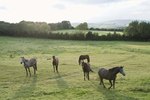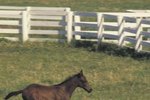
It’s frustrating to look forward to an enjoyable ride on your horse, only to have him balk and refuse to move forward. If you don’t find a physical reason for the behavior, you need to correct the problem before it mushrooms into a bigger and more frustrating issue. Otherwise, your horse will continue to take advantage of you and get out of work in the process.
On the Ground
Going back to groundwork basics not only reinforces the forward cues to your horse, but it also allows you to observe her for physical problems, such as a shortness in her stride or a hitch in her step. If you’ve never done ground work with your horse, start from the beginning by teaching her to respect your commands to back-up, yield her shoulders and hindquarters, and walk forward on the lungeline. Continue this work until she is moving freely at the walk, trot and canter, and changes directly immediately when asked. These lessons will transfer from the ground, to the saddle.
Clear Cues
When you ask your horse to walk, be sure of two things: First, that you are asking her clearly with your legs and your seat; and second, that you are not simultaneously pulling back on the reins. Once you're sure your cues are clear, squeeze with your legs and push down with your seat. If she does not respond immediately by going forward, increase your leg and seat pressure. If she still does not respond with forward movement, kick. Once she responds, keep her going forward for a few minutes, then stop and praise her profusely.
Spurs and Crop
If your horse needs extra encouragement, take a riding crop for your next practice session. If you are an experienced rider, you can also use small spurs but don’t use them unless you’re sure you can control them. Ask her to go forward with your legs and seat; if she doesn’t respond after you ask twice, tap the crop behind your leg. Repeat this until she realizes she avoids the crop by moving when you ask her with your natural aids -- your legs and seat. Once she is moving forward, keep her moving into a trot before you ask her to halt.
Mix it Up
Your horse gets bored just like you do, so mix up your riding habits. In the arena, trot over poles or small cavalettis, which are slightly raised poles. This encourages horses to pick up their feet. Do patterns like serpentines and figure-eights. If you ride English, pique your horse’s interest by taking her around a few barrels or play some Western games with friends, like racing to the end of the arena. Western riders can jump over cavalettis or small logs. If you ride in an arena every day, get out of there and go on a trail ride. The more variety you add to your riding, the more your horse will wonder what you have planned for the next ride and forget about balky behavior.
References
Resources
Photo Credits
-
Jupiterimages/Pixland/Getty Images
Writer Bio
Based in Central Texas, Karen S. Johnson is a marketing professional with more than 30 years' experience and specializes in business and equestrian topics. Her articles have appeared in several trade and business publications such as the Houston Chronicle. Johnson also co-authored a series of communications publications for the U.S. Agency for International Development. She holds a Bachelor of Science in speech from UT-Austin.




